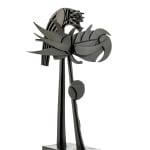

Shinkichi Tajiri Dutch-American, 1923-2009
Bronze
26 5/8 x 16 7/8 x 13 inches
"The Warrior, Guerrier, and Samurai were recurrent themes in my work. They expressed the need to purge myself of the horrors of the war. Sculpturally they were based on medieval armour and shamanistic fetishes." - Shinkichi Tajiri
Tajiri's last series of warrior sculptures are entitled 'Ronin'. A Ronin is a Samurai who has no master to serve, the explanation for that being is when a Daimyo (military lord) dies, his warriors automatically becomes a Ronin. In 1995 Tajiri returns to the theme of the warrior when he receives a commission from the VVDM and the AVNM, both organised interest groups for Dutch military personnel, by mediation of Stroom HCBK (Center for the visual arts The Hague), and in connection with the abolition of conscription. The Ronin figures are made up entirely of flat shapes, which are first cut out of sheets of centafoam. The paradoxical aspect which typifies Tajiri's work is most apparent in the fact that the Ronin are proud and heroic in appearance, yet are very fragile and breakable in material. As a soldier, Tajiri personally experienced man's fragility and vulnerability. Tajiri continued to work on a series of Ronins inspired by the story about the suicide of 47 ronin - samurai without master - in 1700.
Text: H. Westgeest, Silent Dynamism and Oneness in Multiformity, Waanders Publishers, Zwolle, Cobra Museum voor Moderne Kunst, Amstelveen, 1997
Provenance
Shinkichi Tajiri Estate, The NetherlandsExhibitions
Amstelveen, The Netherlands, Cobra Museum, Tajiri, Stille dynamiek en eenheid in pluformiteit, 1997
Herning, Denmark, Museum Carl-Henning Pedersen en Else Alfelt, Dialogue: Shinkichi Tajiri, 1998
Venlo, The Netherlands, Museum van Bommel van Dam, Ronin, 2000
Bremen, Germany, Gerard Marcks Haus, Tajiri, Bildhauerei gegen die Langeweile, Retrospective exhibition, 2001
Amstelveen, The Netherlands, Cobra Museum, Tajiri & Family, 2001
Nijmegen, The Netherlands, Museum Het Valkhof, Shinkichi Tajiri: Snelheid, Erotiek en Geweld, 2003
Rotterdam, The Netherlands, Wereldmuseum, The World of Manga, 2013


